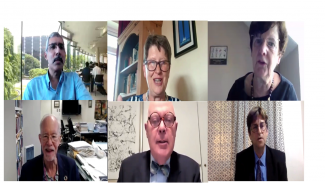
While online teaching and learning is not a recent development in higher education, lockdowns arising from the Covid-19 pandemic have clearly accelerated its adoption worldwide over the past eighteen months. Much has been debated about how this fast-tracked evolution will bring about long-term changes to instructional delivery even after the pandemic is over.
Yet amid this paradigm shift, it remains fundamentally important for educators to persist in contemplating the reasons for, and the value-add of, employing and integrating technological tools into curriculum design.
Prof Venky Shankararaman, Vice-Provost (Education) at Singapore Management University (SMU) shared this perspective at a virtual dialogue, themed “Minding the Gap: Rethinking Curriculum, Pedagogy and Assessment amid the Covid-19 Disruption”, on 21 July 2021. The panel discussion was part of the three-day World Universities Summit organised by the International Institute for Higher Education Research & Capacity Building (IIHEd) of O.P. Jindal Global University (JGU).
The Summit brought together more than 150 thought leaders around the world to deliberate on the ways in which higher education institutions could strengthen their vision and commitment towards institutional resilience, social responsibility and community impact. In line with SMU Vision 2025’s strategic priority of "Growth in Asia", where the University seeks to share good practices and gain understanding of Asia’s economy, polity and society, Prof Shankararaman shared his views on the effective integration of technology with pedagogy and learning.
Prof Shankararaman’s fellow panellists in the lively discourse included the University of Warwick’s Provost, Prof Chris Ennew OBE; Somerville College Oxford’s former Principal, Dr Alice Prochaska; Macquarie University’s Vice-Chancellor, Prof S. Bruce Dowton; and United Nations University’s Rector, Prof David M. Malone. JGU Dean of Jindal School of Art and Architecture, Prof Thomas E. Mical, moderated the session.
“Don’t use technology for the sake of it,” stressed Prof Shankararaman. Instead, he urged educators to always consider if technological tools were appropriate and effective for specific courses and their intended learning outcomes. He urged educators to consider “how technological tools are blended into the pedagogy”.
Prof Shankararaman cited SMU-X, SMU’s flagship experiential learning programme where students work on projects aimed at solving real world issues faced by organisations, as a case in point. Adapting the programme to an online format has made it possible for students to continue to collaborate with companies for projects during the pandemic. However, such an arrangement may not necessarily provide the same immersive experience that comes with students being physically present at the companies for in-person interactions in corporate settings.
Likewise for SMU-X Overseas projects, or SMU-XO in short, which focus on business challenges outside Singapore. A fully online curriculum means forgoing opportunities for students to immerse themselves in the culture of the country of overseas-based partner organisations.
A partially-digital curriculum could be a viable balance when travel restrictions and social distancing rules started to ease, said Prof Venky. He highlighted that an important dimension to consider would be the value of the digital components, and how they might be blended meaningfully with the existing experiential pedagogy and learning outcomes.
Concurring, Dr Prochaska expressed her views that in-person teaching would continue to be a vital component to the learning process. Prof Malone quipped that “there was almost a stampede” for the rare few in-person classes that were opened for enrolment during the last few months, illustrating how much students missed and valued in-person teaching and interactions.
Even if technology was not a magic bullet, the panel agreed that its accelerated adoption has enabled a huge range of opportunities to open up for higher education delivery. Prof Ennew cited the development of micro-credentials, and a wider reach beyond just geographical-mobile student populations as examples of such opportunities.
During the 75-min session, the panellists also discussed the prospects of moving away from traditional prescriptive to outcome-based curriculum and assessment, and ensuring fairness and equity in the context of disparities in technology availability.
Prof Shankararaman shared SMU’s experience in supporting students’ pivot to an online curriculum. The University made laptops and dongles available on loan, and organised workshops to familiarise students with the digital platforms and tools that the course instructors would be using.
The Summit was organised by JGU – SMU’s first Indian partner university for a postgraduate direct admissions collaboration, and a student exchange scheme involving short-term and semester-long study. Both universities signed a Memorandum of Understanding for the collaborations in March this year.